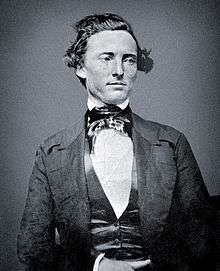Samuel Hamilton Walker
| Samuel Walker | |
|---|---|
 Samuel Hamilton Walker | |
| Born |
Samuel Hamilton Walker February 24, 1817 Toaping Castle, Maryland, United States |
| Died |
October 9, 1847 (aged 30) Huamantla, Tlaxcala, Mexico |
| Occupation | Army Captain, Texas Ranger |
| Spouse(s) | Ali Walker |
| Children | 15 |
Samuel Hamilton Walker (February 24, 1817 – October 9, 1847) was a Texas Ranger captain and military officer of the Republic of Texas and the United States armies. Walker served in several armed conflicts, including the American Indian Wars and the Mexican-American wars.
Biography
Walker was born on February 24, 1817 at Toaping Castle in Maryland to Nathan and Elizabeth (Thomas) Walker and was the fifth of seven children.[1]
Military
Walker enlisted in the Washington City Volunteers for the Creek Indian Campaign in Alabama in 1836. The following year he mustered out of the Volunteers and worked as a scout in Florida until 1841. He arrived in Galveston, Texas in 1842 and served under Captain Jesse Billingsley against the Mexican invasion led by General Adrian Woll. Walker was captured by the Mexicans on December 26, 1842 and marched to Mexico City as a prisoner of war. He survived what became known as the Black Bean Episode and held prisoner for two years before escaping to Louisiana and returning to Texas.[2][3]
He then joined the Texas Rangers in 1844 under the command of Captain John Coffee Hays. Promoted to the rank of captain, he later led a Ranger company in the Mexican–American War with General Zachary Taylor and General Winfield Scott's armies.[4]
Walker Colt

Walker is best known as the co-inventor of the famous Walker Colt revolver, along with arms manufacturer Samuel Colt. Walker is said to have self-funded a trip to New York City to meet with Colt and proposed to him the concept of a weapon based on the then-popular five-shot Colt Paterson revolver, with many enhancements such as adding a sixth round, being powerful enough to kill either a man or a horse with a single shot and quicker to reload .[5]
The problem was that Colt's firearms company was no longer doing business at that time. The large order allowed Colt to establish a new firearm business. Colt hired Eli Whitney Blake, who was established in the arms business, to make his revolvers.[6]
Colt used his prototype and Walker's improvements as the basis for a new design. From this new design, Blake produced the first thousand-piece order known as the Colt Walker. The company then received an order for a thousand more; Colt took a share of the profits at $10 per pistol for both orders.[6]
By 1847, the new revolver was produced. The United States Mounted Rifle companies were provided with the new weapons, which proved to be extremely effective.[7]

Death
On October 9, 1847, Walker was killed in Huamantla, in Tlaxcala, while leading his troops in the Battle of Huamantla during the Mexican–American War. He was struck down by a shotgun (escopette, variously escopeta) round fired from a balcony, although popular legend often has claimed the weapon was a lance.[8]
In 1848 his remains were moved to San Antonio. On April 21, 1856, as part of a battle of San Jacinto celebration, he was reburied in the Odd Fellows' Cemetery in San Antonio.[9]
Walker County, Texas was renamed for him after the original namesake, Robert J. Walker, sided with the Union during the Civil War.[10]
See also
References
- ↑ Charles D. Spurlin. "WALKER, SAMUEL HAMILTON". Handbook of Texas Online (See "Notes" section). Texas State Historical Association. Retrieved May 2, 2011.
- ↑ Glasrud, Bruce A.; Weiss, Harold J. (2012). Tracking the Texas Rangers: The Nineteenth Century. University of North Texas Press. pp. 90–92. ISBN 978-1-57441-465-3.
- ↑ Herrera-Sobek, María (2012). Celebrating Latino Folklore: An Encyclopedia of Cultural Traditions. ABC-CLIO. p. 722. ISBN 978-0-313-34339-1.
- ↑ Bauer, K. Jack (1 August 1993). Zachary Taylor: Soldier, Planter, Statesman of the Old Southwest. LSU Press. p. 150. ISBN 978-0-8071-1851-1.
- ↑ Rick Sapp (2007). Standard Catalog of Colt Firearms. F+W Media, Inc,. pp. 35–40. ISBN 978-0-89689-534-8.
- 1 2 Adler, Dennis (2008). Colt Single Action: From Patersons to Peacemakers. Edison, New Jersey: Chartwell Books. p. 62. ISBN 978-0-7858-2305-6.
- ↑ "New pistols" (PDF). Texas Ranger Museum.
- ↑ "Walker's Walkers: The Colt Walker Revolvers of Captain Samuel H. Walker, Texas Ranger" (PDF).
- ↑ Franscell, Ron (9 November 2010). Crime Buff's Guide to Outlaw Texas. Rowman & Littlefield. p. 77. ISBN 978-0-7627-7493-7.
- ↑ Cox, Mike (7 September 2015). Gunfights & Sites in Texas Ranger History. Arcadia Publishing Incorporated. p. 47. ISBN 978-1-62585-487-2.
Further reading
- K. Jack Bauer, The Mexican War, 1846–1848 (New York: Macmillan, 1974).
- Albert Gallatin Brackett, General Lane's Brigade in Central Mexico (Cincinnati and New York: Derby, 1854).
- Edmund L. Dana, "Incidents in the Life of Capt. Samuel H. Walker, Texan Ranger," Proceedings of the Wyoming Historical and Geological Society (1882).
- "Reminiscences of the War with Mexico, As Told by Col. Thos. Claiborne," Vedette 7 (April 1886). Marilyn M. Sibley, ed., Samuel H. Walker's Account of the Mier Expedition (Austin: Texas State Historical Association, 1978).
- Charles D. Spurlin, "Ranger Walker in the Mexican War," Military History of Texas and the Southwest 9 (1971).